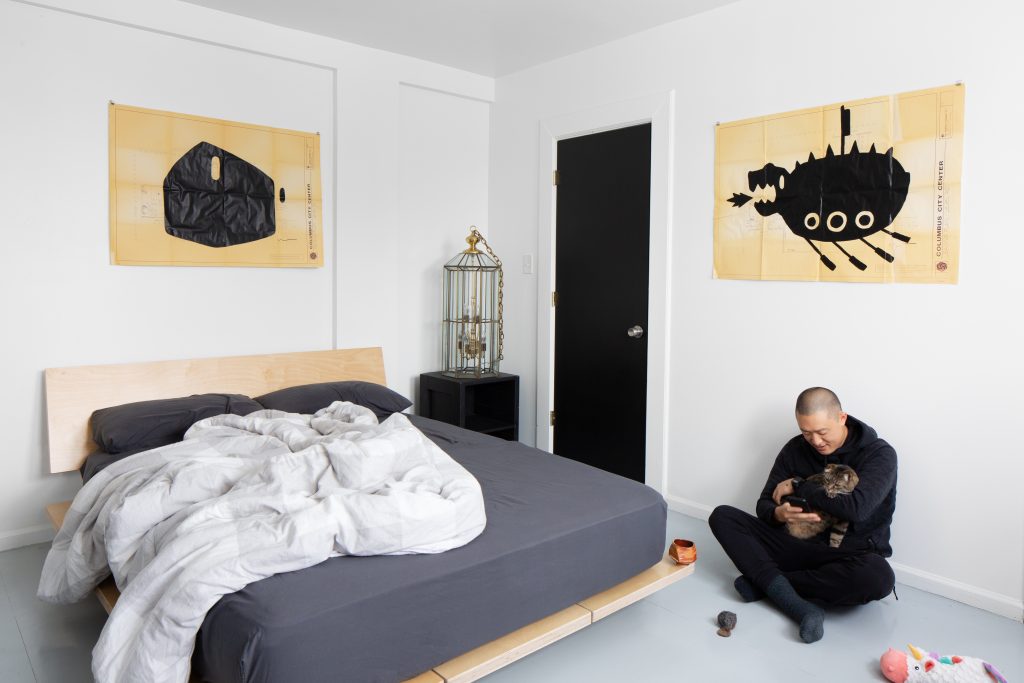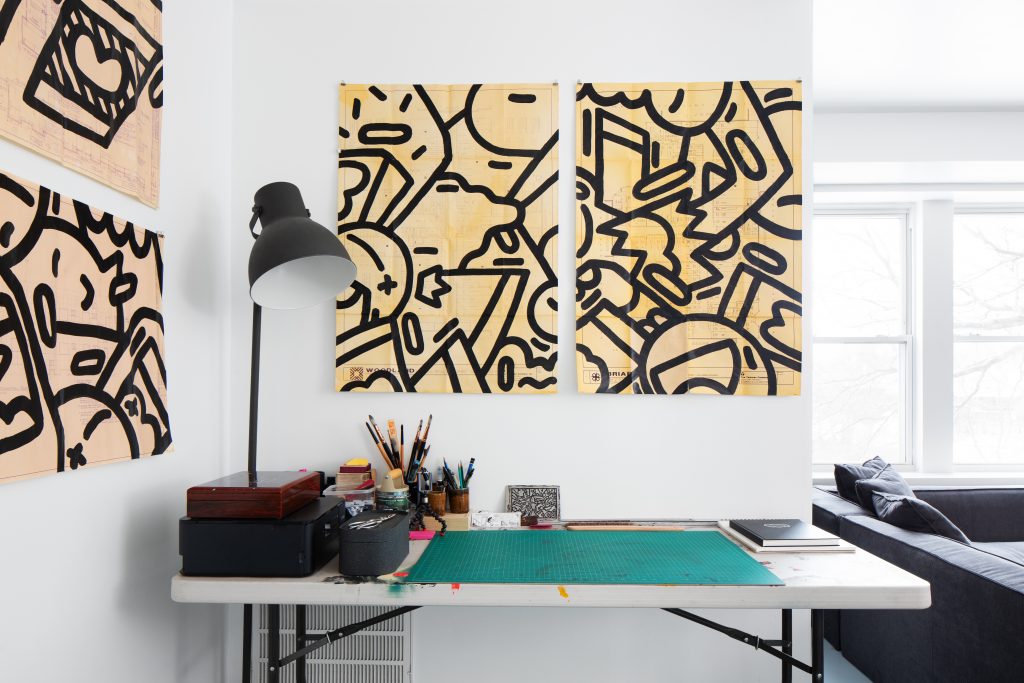We are all holding our breath to see how the world will be reborn after COVID.
That is why Mike Han, a man familiar with the feeling of rebirth, may be the perfect artist to capture the current mood.
COVID took away his dream of opening a restaurant in Detroit.

He was just one month away from opening “Pursue Underground,” an intimate eight-seat counter service Korean-American sushi restaurant in Ann Arbor, when COVID shut everything down. It was his third try at opening a restaurant. “Pursue Detroit,” which was inside the Fort Street Galley, was opened from November 2018 to April 2019.
He was devastated, but not down for the count.
“2020 crushed my soul and took away a career I was deeply passionate about and worked terribly hard for, but it also brought me new life,” says Han, who was then unemployed with no hope of practicing his craft.
Determine to reimagine himself, Han was reborn as an artist, something he says he had not had the courage to pursue before.
Inspired by both a personal need for rebirth and more than a decade of observing Detroit’s renaissance and now a world and a city torn apart by COVID, Han put together an art show called Altered Plans, that he says represents the times and is an allegory to the city … and perhaps himself.
In true pandemic style, the show is hosted virtually from his Detroit apartment. You can see the work through January 31 by clicking here.
Han’s art is heavily inspired by his personal story, which is a tale of hope, dreams, set-backs, self-described failures, and pride in both his Korean and Detroit heritage. Even how these paintings come from a mixture of these diverse elements.

A few years ago, discovered a set of blueprints in the rubble of the old Meyer Jewelry Co. building on Woodward. He kept the blueprints for eight years and now found a purpose. They became part of the art he is displaying.
“The work is about identity,” says Han.
His black-and-white style is inspired by Asian calligraphy … mostly the Korean style … as well as graffiti. Even the medium is a mix of these elements. He painted with “bone black” acrylic paint, which uses bone char made by Ebonex. That company has made the pigment just outside Detroit for more than 150 years.
The strength of Ebonex, and the black-and-white aesthetic leave little room for error.
“You have one brush, and you have one chance to make it work,” says Han.
This pigment was chosen so that no matter what his freeform, stream-of- thought painting produces, it is still represents rebirth. The dead animals create something new – a kind of renaissance.
The color black has another meaning as well.
“It’s a representative of all the colors of the spectrum,” says Han, adding one must look harder to see the spectrum.
Han’s history in art goes back more than a decade. He originally used his skills to help beatify the city he grew to love, notably painting windows on Woodward when so many buildings were vacant on the street. The goal then was to bring some life and hope to the area through public art.
Han, who founded as group called Street Culture Mash, was one of people who spearheaded the project.
Notably, he finished a black-and-white mural of the flag of Detroit on the Dequindre Cut on the underpass right before the pedestrian entrance off of Gratiot, the day the city filed for bankruptcy. That was one of the earliest times the concept of rebirth touched his life.

Just before this, he found that set of blueprints from 1988 for the Meyer Jewelry Co. located at Woodward and Grand River Avenues, in the rubble inside the empty building. The blueprints documented the Meyer’s rise and its expansion into shopping malls across Michigan and into Columbus City Center in Ohio.
“Finding these plans among the discarded rubble in a shell of a building made me feel the pain of going out of business in a visceral way.” Han says. “Unbeknownst to me, they would foreshadow the fate of plans I would create in Detroit.”
Han says he felt the pain of going out of business as he worked to make the city more livable.
However, he would not be making this art for the show if he had not had the dream of opening a restaurant fall apart.
Han travelled across the country learning how to best prepare sushi, and for the first time learned about the turbulent history between Korea and Japan.
At one point, while he studied in New York, he used a knife with a name engraved on it … Hideyoshi … the Japanese emperor who invaded Korea. This set a course for him, the creation of Korean-American sushi, made with Korean and American flavors … preferably Michigan or Detroit … ingredients. Han says getting American-made or American-grown ingredients alone is rare.
He uses those same Korean-American influences in the art featured in the virtual show.
It was inspired in part by him being found in the middle of the two worlds.
As a child, Han’s family moved around, and he often found himself the only Asian American and sought to know more about that side of himself.
First, his interest in anything Asian brought him to sushi, before long, he wanted to infuse it with flavors from his Korean heritage.

To learn more, he visited Korea but there found his Americanness was very apparent. He was unable to count high enough in Korean to use the money easily, and his tattoos made people think he was involved in crime.
Detroit was the American city where he felt most at home, despite living all around the country as a child and adult. So, after becoming a sushi chef he opened his restaurant, Pursue Underground.
This culinary manifestation of Han’s identity didn’t last long. Like all too many stories in 2020, COVID painted an “the end” on his dream, on May, 1 2020.
Unsurprising, Han fell into a depression when his restaurant closed. Still, he rose from the ashes and reimagined himself again by going to school and studied a UX Design Immersive course online from General Assembly.
Today he has started a remote design business called Eightness, with a partner he met from the class.
Han was ready to confront what had happened and moved to express himself.
What better way than with those blueprints he’d fished out of the rubble in the Meyer Jewelry Co store, which also found rebirth. It is now the Shinola Hotel.
Han turned the blueprints into something he had never made, a self-portrait.
His art combines his personal identity and juxtaposes it with the rebirth of his personal life, his city, and 2020 … the year that took so much.
“This is a time capsule of Detroit,” says Han. “It is a moment that captures a decade of my personal trials and failures in the city where my mother immigrated to with her parents and her brothers nearly 50 years ago, against the backdrop of a world that has collapsed.”
Han hopes the show will serve as a beacon of hope.
Altered Plans is done virtually, but small, limited in-person showings are possible by appointment.
The show ends on January 31. More information can be found here.


